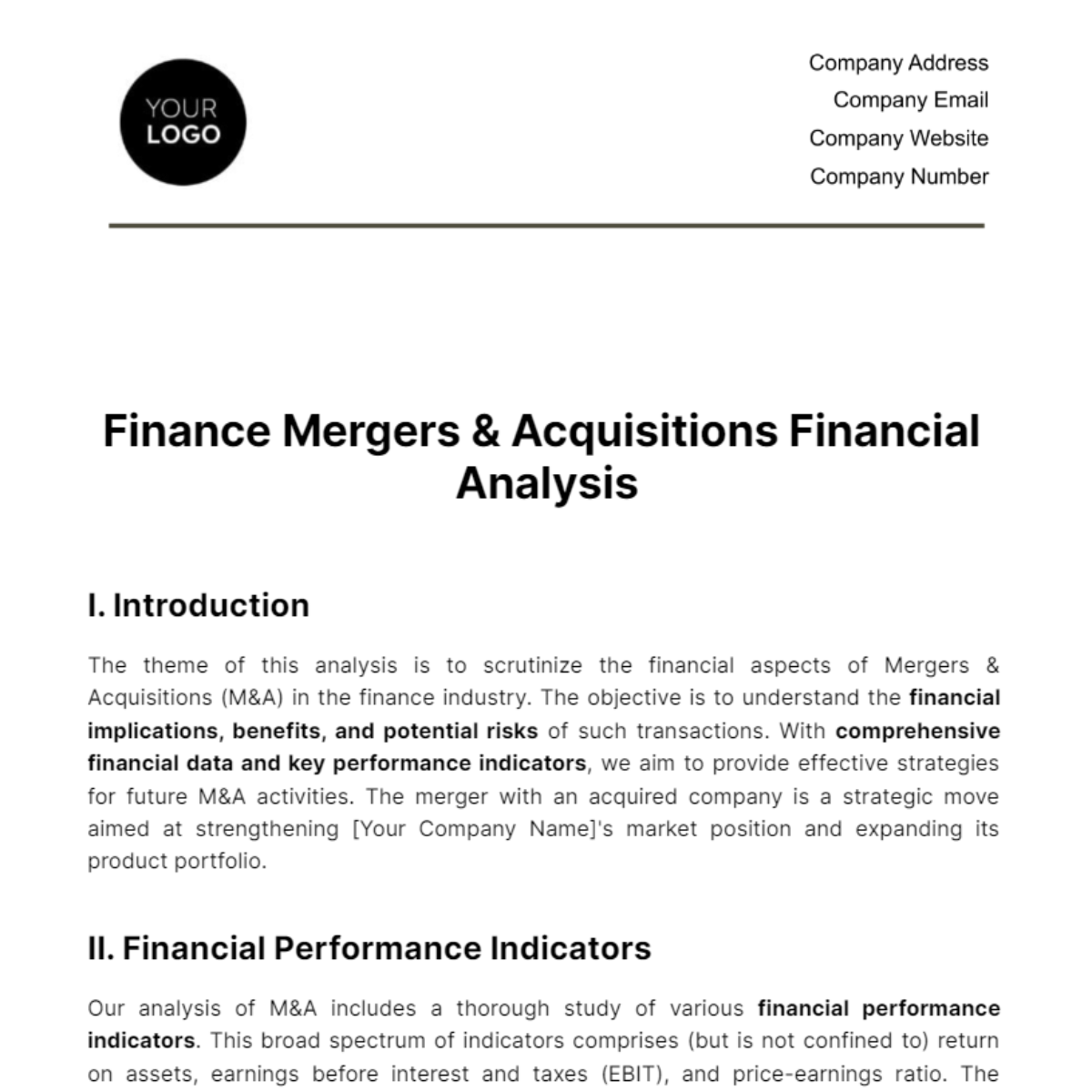Free Finance Mergers & Acquisitions Financial Analysis

I. Introduction
The theme of this analysis is to scrutinize the financial aspects of Mergers & Acquisitions (M&A) in the finance industry. The objective is to understand the financial implications, benefits, and potential risks of such transactions. With comprehensive financial data and key performance indicators, we aim to provide effective strategies for future M&A activities. The merger with an acquired company is a strategic move aimed at strengthening [Your Company Name]'s market position and expanding its product portfolio.
II. Financial Performance Indicators
Our analysis of M&A includes a thorough study of various financial performance indicators. This broad spectrum of indicators comprises (but is not confined to) return on assets, earnings before interest and taxes (EBIT), and price-earnings ratio. The analysis of these indicators presents a complete picture of the financial health, cash flow, profitability, and market value of firms involved in M&A.
III. Performance Analysis of Merged Entities
We are scrutinizing a comparative analysis of the pre and post-merger performance of the involved entities. This analysis can reveal potential benefits and threats associated with M&A, helping stakeholders make informed decisions. The assessment of financial performance post-merger is crucial in providing a clear perspective on whether the merger has achieved its intended objectives.
IV. Comparative Sector Performance
Another essential part of our analysis includes evaluating the performance of the merged entities against the sector-wide performance. It highlights the overall impact of the merger on the competitive landscape and enables us to identify potential market trends and risks.
V. Risk Assessment and Mitigation
M&A is a significant strategic decision accompanied by various risks - operational, financial, and market-related, among others. We strive to identify these potential risks and provide proactive measures for risk mitigation. These steps may include extensive due diligence, financial restructuring, or adopting new risk management strategies.
Integration Risks: The successful integration of an acquired company into [Your Company Name] may face hurdles such as aligning cultures, systems, and processes, which could impact operational efficiency.
Market Conditions: External factors, like economic downturns or changes in consumer preferences, may affect sales and revenue generation, potentially impacting the financial performance post-merger.
Regulatory Hurdles: Meeting legal and regulatory requirements, especially in industries with strict regulations, may pose challenges that need to be carefully navigated during the merger and integration process.
VI. Actionable Recommendations
Based on our findings, we provide specific, actionable recommendations tailored for both companies and investors. These recommendations can help in shaping a successful M&A strategy, increasing shareholder value, and mitigating potential risks.
VII. Conclusion
The financial analysis of Mergers & Acquisitions offers valuable insights into the financial benefits, challenges, and risks associated with these strategic decisions. The comprehensive overview provided in this report not only promotes data-backed decision-making but also equips stakeholders with actionable strategies for the future. However, it also comes with integration challenges and market risks. A thorough analysis of financial performance, valuation, and sensitivity is crucial in managing these risks effectively.
[Your Company Name] remains optimistic about the long-term benefits of this M&A transaction and is committed to realizing its strategic objectives.
- 100% Customizable, free editor
- Access 1 Million+ Templates, photo’s & graphics
- Download or share as a template
- Click and replace photos, graphics, text, backgrounds
- Resize, crop, AI write & more
- Access advanced editor
Presenting the Finance Mergers & Acquisitions Financial Analysis Template from Template.net. This professionally designed template offers a detailed approach for financial analysis in M&A scenarios. It is entirely editable and customizable to suit specific business requirements, ensuring comprehensive and accurate financial evaluations in the dynamic world of finance mergers and acquisitions.





























